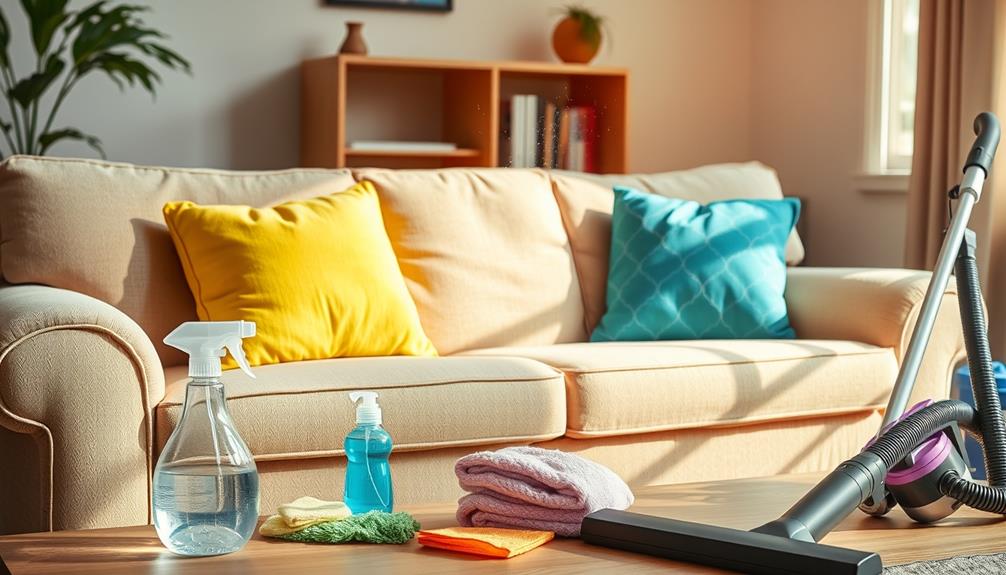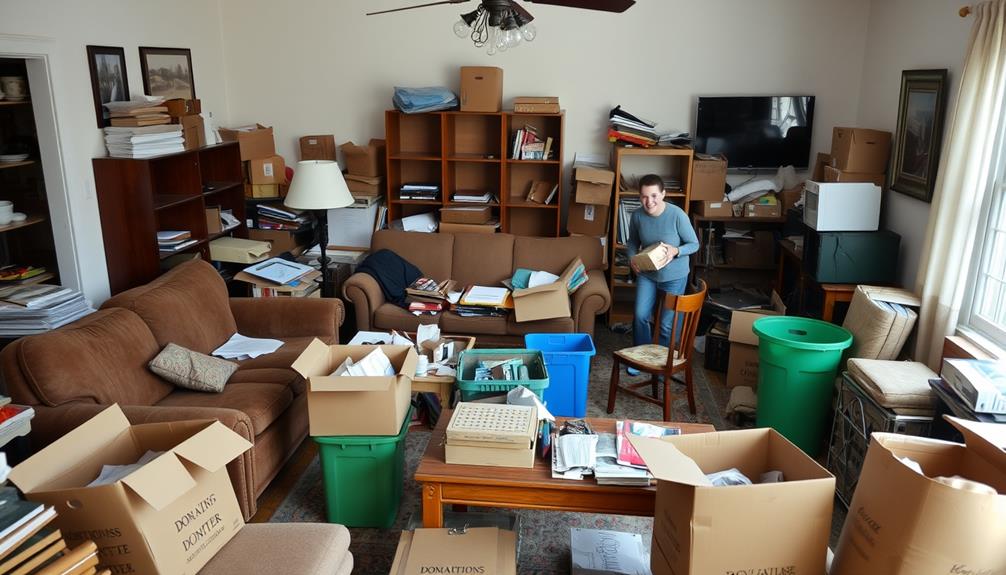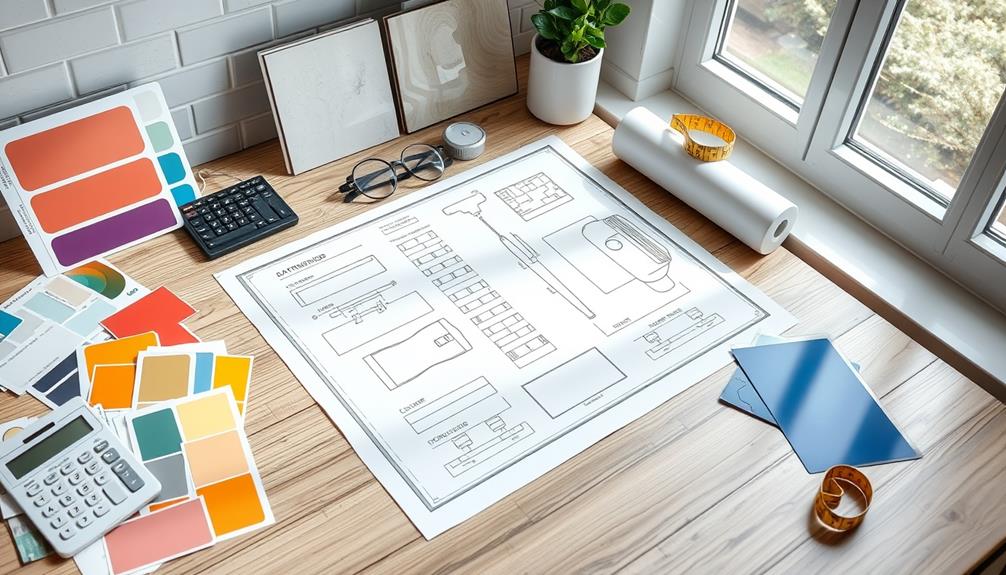To maintain your fabric sofa at home, start by examining the cleaning tag for specific instructions. Thoroughly vacuum it using an upholstery attachment to remove dust and dirt. For stains, create a DIY solution of water, dish soap, and vinegar, then apply it with a microfiber cloth while gently blotting the area. To get rid of odors, sprinkle baking soda on the fabric and vacuum it up after 20 minutes. Depending on the fabric, steam cleaning may be an option, but always ensure proper drying afterwards. There is a wealth of information available on keeping your sofa looking great and lasting longer. If you are dealing with stubborn, deeply embedded stains or odors that won’t go away, consider removing old furniture and hiring a professional upholstery cleaner. They have the necessary tools and techniques to tackle tough stains and bring your sofa back to its former glory. Don’t forget to regularly fluff and rotate the cushions to maintain their shape and comfort. With proper care, your fabric sofa can remain a beautiful and functional piece of furniture in your home for many years.
Key Takeaways
- Check the manufacturer's cleaning tag for specific codes to determine safe cleaning methods, such as "W" for water-based cleaners or "S" for solvent-based.
- Vacuum the sofa thoroughly with an upholstery attachment to remove dust and debris before applying any cleaning solution.
- Use a DIY cleaning solution of water, dish soap, and vinegar, applying it with a microfiber cloth to treat stains gently.
- Sprinkle baking soda to absorb odors, let it sit for 20 minutes, and then vacuum it off for freshness.
- Regularly maintain your sofa by vacuuming weekly, fluffing cushions, and deep cleaning every 12 to 18 months.
Importance of Manufacturer's Instructions

When it comes to cleaning your fabric sofa, the manufacturer's instructions are your best friend. These guidelines are fundamental for guaranteeing you use the correct cleaning methods tailored to your specific sofa type. Ignoring these instructions can lead to damage, void warranties, and compromise your sofa's integrity.
For instance, just as with pet care, understanding the specific needs of your fabric can prevent issues like discoloration or deterioration, making adherence to these guidelines essential for maintaining quality. Make certain to check the cleaning tag on your cushions, as it provides valuable codes (W, S, WS, X) that dictate what cleaning solutions are safe to use. Ultimate Hamster Care Guide
Following the recommended care instructions is critical for preserving the fabric's appearance and extending its longevity. Improper cleaning can result in discoloration or deterioration, which you definitely want to avoid.
Before applying any cleaning solution, always conduct a spot test on a hidden area to verify there are no adverse reactions. This simple step can save you from potential mishaps.
Understanding Cleaning Tags
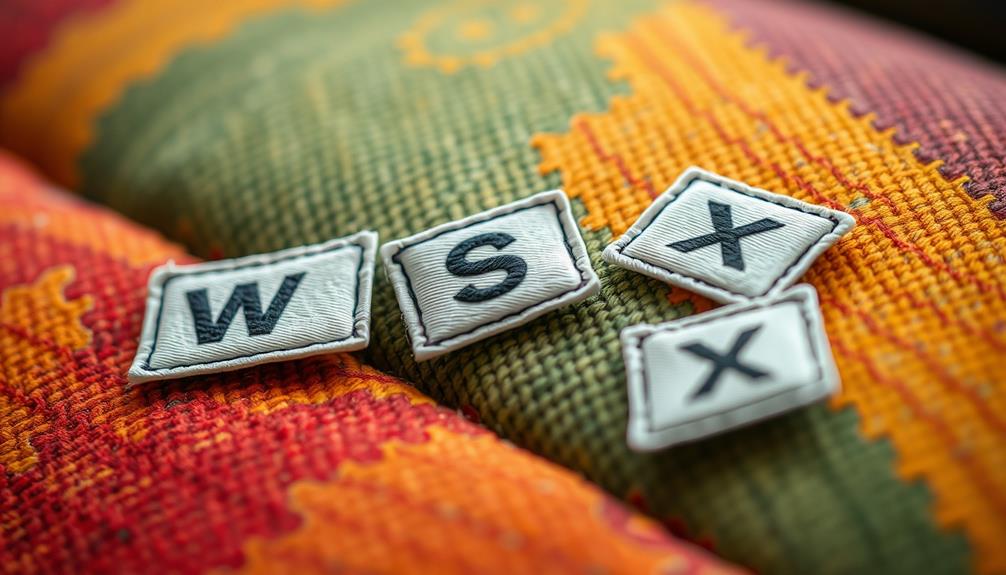
Before you start cleaning your fabric sofa, check the cleaning tag for important codes.
These codes, like "W" or "S," tell you which cleaning methods are safe to use, helping you avoid damage.
Understanding the significance of these codes can help prevent costly mistakes, similar to how knowing about email etiquette can enhance professional communication.
Knowing where to find the tag and understanding its significance can save you time and effort in maintaining your sofa.
Cleaning Code Definitions
Understanding cleaning codes on fabric sofas is essential for maintaining their appearance and longevity. Following the right cleaning methods can greatly enhance the cleaning effectiveness and prolong the lifespan of your furniture, similar to how air purifier maintenance requires adherence to specific guidelines for peak performance.
These codes help you choose the right cleaning method to avoid fabric deterioration and keep your sofa looking fresh. Here's a quick guide to the most common cleaning codes:
- W code: This means you can use a water-based cleaner. It's perfect for DIY solutions with distilled water and mild detergents.
- S code: Fabrics marked with this code require solvent-based cleaners only. Be careful, as using the wrong product can damage the fabric.
- WS code: This versatile code lets you use both water-based and solvent-based cleaners, giving you more options for cleaning.
- X code: If you see this code, only vacuuming or light brushing is allowed. Avoid any moisture or cleaning solutions to prevent damage.
Importance of Proper Cleaning
Proper cleaning is essential for maintaining your fabric sofa's appearance and durability. Understanding cleaning tags is important as they indicate the appropriate cleaning method for your specific upholstery fabric.
By adhering to the cleaning codes—like "W," "S," "WS," and "X"—you'll know whether to use water, solvent-based cleaners, or just vacuuming for maintenance. Ignoring the manufacturer's instructions can lead to irreversible damage and may even void any warranties.
Additionally, utilizing non-toxic cleaning solutions can be beneficial for both your health and the environment, as seen in home remedies for cleaning.
Using the correct cleaning agents is essential for preserving the fabric's integrity. Proper cleaning helps prevent damage that could arise from using the wrong products, ensuring your sofa stays looking fresh and new.
Following the recommended methods based on those tags not only maintains appearance but also extends the longevity of your upholstered furniture.
Tag Location and Significance
Check the underside of your sofa cushions or the back of the sofa to find the cleaning tag, as it's vital for proper maintenance.
These cleaning tags are important for understanding how to care for your fabric sofas without causing damage. Each tag features specific codes that guide your cleaning methods, guaranteeing that you handle stains effectively while preserving the fabric's integrity.
For example, using energy-efficient appliances can help you maintain your home environment while reducing overall energy consumption.
- W code: This means you can use water-based cleaning agents. It's a versatile option for most stains.
- S code: Only solvent-based cleaners are allowed here. Make sure to use the right products to avoid damaging the fabric.
- WS code: This code allows for both water and solvent-based cleaners, giving you the flexibility to choose the best method for your cleaning needs.
- X code: For fabrics marked with this code, only vacuuming is permitted. Stick to this guideline to maintain the integrity of the fabric and avoid voiding warranties.
Always check your cleaning tags before starting any cleaning process. Following these guidelines guarantees that your fabric sofas remain in great condition for years to come!
Cleaning Stained Fabric Sofas

When it comes to cleaning stained fabric sofas, having the right supplies is key.
Essential oils, such as eucalyptus oil for its decongestant properties, can also help freshen the fabric while you clean.
You'll need a mixture of distilled water, dish soap, and vinegar for effective stain removal.
Let's explore the best techniques to tackle those stubborn stains and keep your sofa looking fresh.
Necessary Cleaning Supplies
To effectively clean stained fabric sofas, you'll need to gather several essential supplies that make the process easier and more efficient. Having the right cleaning supplies on hand guarantees you can tackle stains promptly and maintain your sofa's appearance.
Regular maintenance and cleaning can help prevent build-up and prolong the life of your sofa, similar to the importance of using the right cold medications for effective relief.
Here's a list of what you need:
- Vacuum Cleaner with Upholstery Attachment: This helps remove debris and prepares your sofa for deeper cleaning.
- Microfiber Cloths: Perfect for applying your cleaning solutions and blotting stains without leaving lint behind.
- Distilled Water: Using distilled water prevents mineral buildup, guaranteeing your cleaning solution works effectively.
- DIY Cleaning Solution: Mix 2 cups of distilled water with 2 tablespoons each of clear dish soap and white vinegar for an effective stain treatment.
Additionally, sprinkle baking soda on your sofa to absorb odors before vacuuming.
Before you start cleaning, always check the cleaning codes on your sofa's care tag (W, S, WS, X) to choose the right methods and supplies.
With these essentials, you'll be well-prepared to tackle those tricky stains and maintain your fabric sofa's beauty.
Effective Stain Removal Techniques
Stains on your fabric sofa can be a real eyesore, but with the right techniques, you can restore its beauty. Start by vacuuming the fabric sofa thoroughly to remove loose dirt and debris, as this step is essential for effective stain removal.
Additionally, maintaining your sofa's cleanliness can prevent common issues that arise from neglect, much like regular toilet maintenance prevents leaks and clogs in bathrooms toilet maintenance tips.
Next, check the cleaning tag to determine the fabric code (W, S, WS, or X) so you can use appropriate cleaning methods.
For most stains, mix a solution of distilled water, dish soap, and vinegar. Using a damp microfiber cloth, gently blot the stain—avoid scrubbing, as it can damage the fabric.
If the stain persists, you might need to use specialized cleaning products like OxiClean, making sure you follow the manufacturer's instructions for safe use.
After cleaning, it's important to verify the area is completely dried. Use a fan or let it air dry to prevent the growth of mildew and odors, which can ruin your cleaning efforts.
Steam Cleaning Techniques
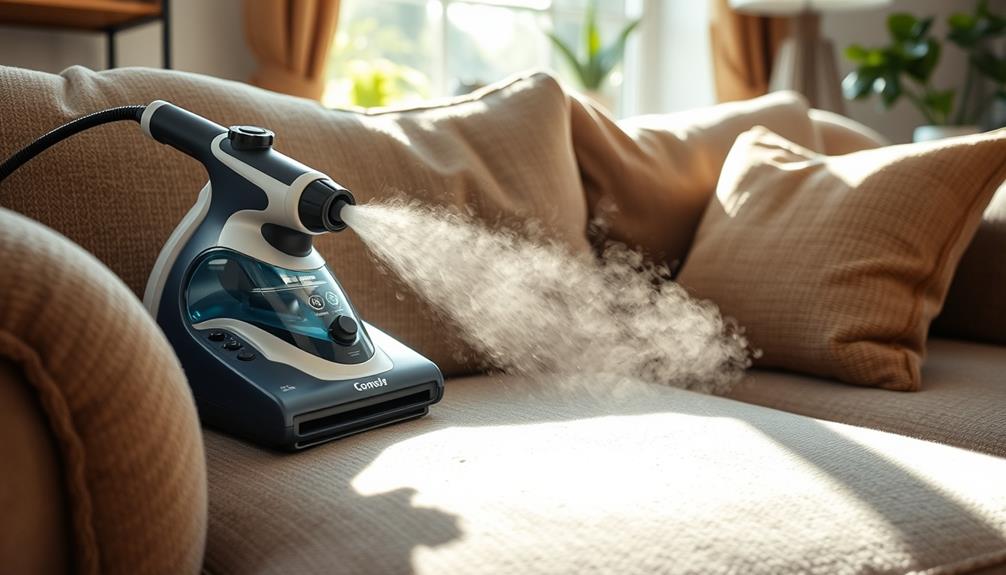
Before diving into steam cleaning your fabric sofa, it's important to verify that your sofa is compatible with this method by checking the care tag for "W" or "WS" cleaning codes.
Best soil for String of Hearts plants can also be significant if you have houseplants nearby, as the steam cleaning process may release some moisture into the air.
Once confirmed, follow these steps for best results:
- Vacuum Thoroughly: Start by vacuuming your sofa to remove loose dirt and debris. This step helps guarantee the steam cleaner can effectively lift dirt and stains.
- Prepare the Steam Cleaner: Use an upholstery cleaning machine set to the appropriate temperature and pressure per the manufacturer's instructions. This will help protect your fabric surface while effectively cleaning.
- Ensure Proper Ventilation: Open windows to allow moisture to escape during the steam cleaning process. This is important to prevent mildew and maintain a fresh environment.
- Allow to Dry Completely: After steam cleaning, it's crucial to let your sofa dry completely. You can use fans to speed up the drying process and avoid any lingering dampness.
Odor Removal Strategies
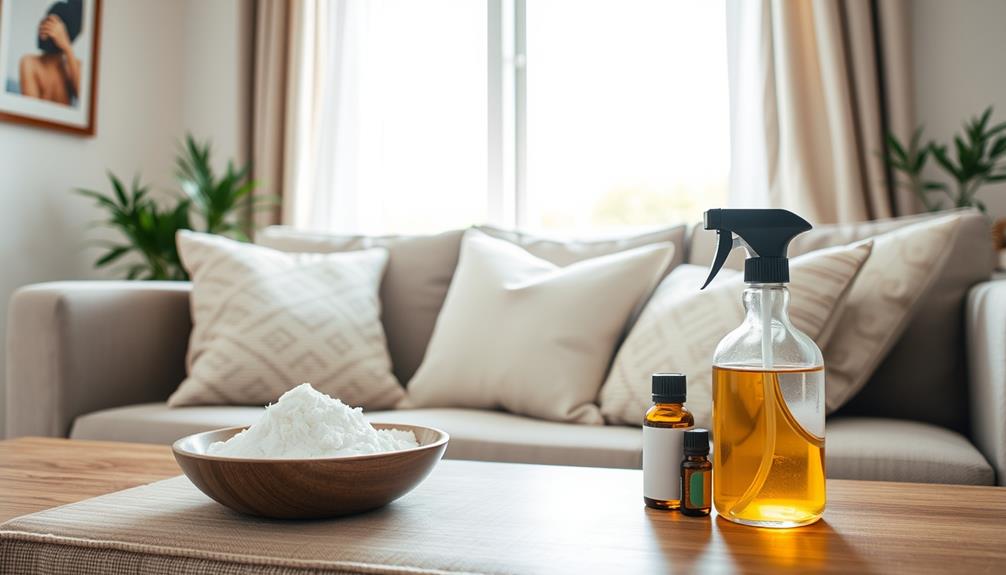
Odors can linger in your fabric sofa, but there are effective strategies to eliminate them. Start by using baking soda, which is a powerful odor absorber. Sprinkle it generously on your sofa and let it sit for 20 minutes to an hour, depending on the severity of the odor.
Afterward, vacuum it off using an upholstery attachment for the best results. For those looking for the best vacuums for effective cleaning, consider options that excel in superior dust and allergen elimination.
For deeper odors, mix vinegar and water in a spray bottle. Lightly mist the fabric and blot with a damp cloth, allowing it to air dry.
Regular vacuuming is essential too; it helps remove surface dust and pet hair that can contribute to lingering smells. Make sure to act quickly by spot cleaning any spills with a damp cloth to prevent odors from settling into the fabric.
If you're dealing with pet odors, consider using enzymatic cleaners. These are specifically designed to break down the organic compounds causing the smell. Just follow the product instructions for the best results.
Supplies and Cleaning Products
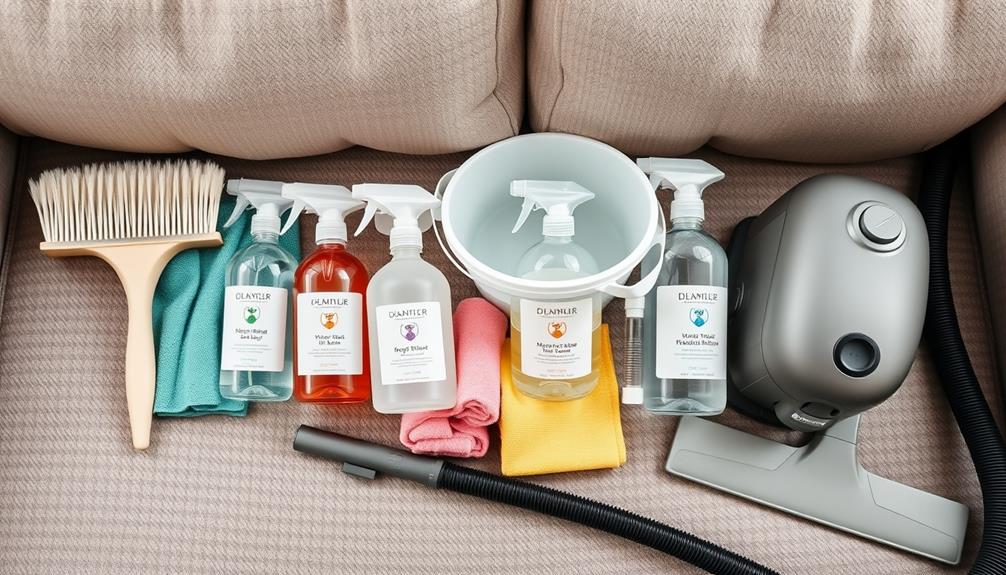
Gathering the right supplies is essential for effectively cleaning your fabric sofa. With the right tools and cleaning products, you can tackle dirt, stains, and odors with ease. Here's a list of must-have items:
- Vacuum Cleaner with Upholstery Attachment: This helps you remove dust and debris from your sofa before applying any cleaning solutions.
- Microfiber Cloths: Use these to wipe down surfaces and apply your DIY cleaner or other products.
- Baking Soda: Great for odor absorption, sprinkle it on your sofa and let it sit before vacuuming it up.
- OxiClean White Revive: This product brightens fabric and works wonders for stains.
When preparing your DIY cleaner, mix 2 cups distilled water, 2 tablespoons clear Dawn dish soap, and 2 tablespoons distilled white vinegar.
Always perform a spot test on a hidden area of your fabric sofa to check for color loss.
For deep cleaning, consider using the Bissell Little Green, which effectively tackles tough stains.
Make sure your cleaning area is well-ventilated to help your sofa dry properly and prevent mildew growth after cleaning.
Regular Maintenance Tips
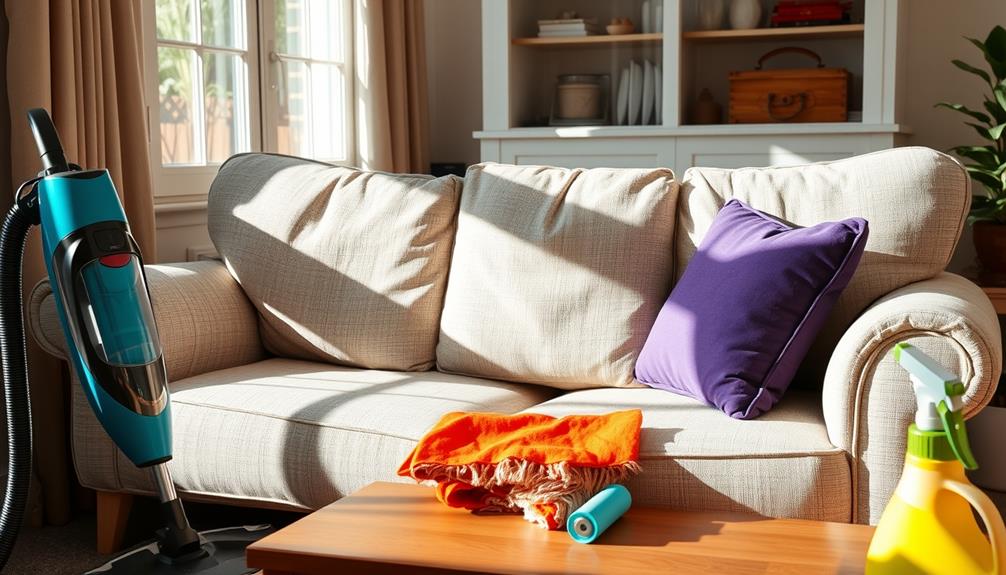
Keeping your fabric sofa looking its best requires regular maintenance. Start by vacuuming at least once a week to remove dust, crumbs, and pet hair. This prevents buildup and helps extend the lifespan of your upholstery.
Every few weeks, fluff and rotate the cushions to maintain their shape and promote even wear, avoiding lumps and sagging.
If you spill something, act quickly and spot clean the area with a damp cloth and a suitable cleaning solution based on the fabric's care tag instructions. This helps prevent stains from setting in.
Consider applying a fabric protector like Scotchgard periodically. This creates a barrier against stains and spills, enhancing the longevity of your sofa.
Additionally, schedule a deep cleaning every 12 to 18 months, whether through professional services or a DIY approach. This refreshes the fabric and eliminates embedded dirt and allergens, ensuring your sofa stays clean and comfortable.
Frequently Asked Questions
What Is the Best Way to Clean a Fabric Sofa?
To clean a fabric sofa, start by vacuuming thoroughly. Then, mix a gentle solution for spot cleaning and test it first. For odors, sprinkle baking soda, let it sit, and vacuum. Always check the care tag! If the care tag recommends it, you can also use a steam cleaner for a deeper clean. For tough stains, consider using a commercial fabric cleaner, but always spot test first. These sofa cleaning tips will help keep your fabric sofa looking fresh and clean for years to come. Remember to always follow the care instructions provided by the manufacturer to ensure the longevity of your sofa.
How Do You Clean a Fabric Couch Without Washing It?
To clean your fabric couch without washing it, start by vacuuming thoroughly. Then, sprinkle baking soda to absorb odors. For stains, gently blot with a damp cloth using a mild cleaning solution. Always test first!
Can I Use Dawn Dish Soap to Clean My Fabric Couch?
Yes, you can use Dawn dish soap to clean your fabric couch. Just mix it with distilled water and vinegar, then spot test first to guarantee it won't cause any discoloration or damage.
What Is the Best Homemade Upholstery Cleaner?
The best homemade upholstery cleaner combines 2 cups distilled water, 2 tablespoons clear Dawn dish soap, and 2 tablespoons distilled white vinegar. Always spot test first, then apply and blot to tackle stains effectively.
Conclusion
In conclusion, maintaining your fabric sofa's freshness and flair is feasible with a few fundamental steps. Following manufacturer instructions, deciphering cleaning tags, and diligently addressing stains can dramatically improve your sofa's appearance. Don't forget to employ effective odor elimination and embrace regular maintenance for lasting longevity. With these savvy strategies, you'll keep your seating stylish, spotless, and serene, ensuring your living space remains a welcoming and wonderful haven for all who enter.
